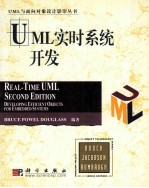
Chapter 1: Introduction to Real-Time Systems and Objects 1
1.1 What Is Special About Real-Time Systems? 2
1.2 Dealing with Time 7
1.3 Model-Based Development 11
1.3.1 Development Activities of the ROPES Process 12
1.4 Advantages of Objects 16
1.5 Object Orientation with UML 19
1.5.1 Objects 20
1.5.2 Attributes 25
1.5.3 Behavior 25
1.5.4 Messaging 29
1.5.5 Concurrency 31
1.5.6 Classes 31
1.5.7 Relations Among Classes and Objects 34
1.6 UML Diagrams and Notation 43
1.7 A Look Ahead 47
1.8 References 47
Chapter 2: Requirements Analysis of Real-Time Systems 49
2.1 Use Cases 50
2.1.1 Actors 50
2.1.2 Requirements 55
2.1.3 Use Case Relations 57
2.1.4 Using Use Cases 59
2.2 Filling Out the Details of the Use Cases 59
2.2.1 Scenarios 61
2.2.2 Sequence Diagrams 62
2.2.3 Message Properties 64
2.2.4 Capturing Time and Timeliness 68
2.2.5 Statecharts and Use Cases 71
2.3 Identifying Use Cases 73
2.4 Looking Ahead 76
2.5 References 77
Chapter 3: Analysis: Defining the Object Structure 79
3.1 The Object Discovery Process 80
3.2 Connecting the Object Model with the Use Case Model 81
3.3 Key Strategies for Object Identification 83
3.3.1 Underline the Noun Strategy 83
3.3.2 Identify the Casual Objects 86
3.3.3 Identify Services (Passive Contributors) 88
3.3.4 Identify Real-World Items 89
3.3.5 Identify Physical Devices 89
3.3.6 Identify Key Concepts 90
3.3.7 Identify Transactions 91
3.3.8 Identify Persistent Information 93
3.3.9 Identify Visual Elements 93
3.3.10 Identify Control Elements 97
3.3.11 Apply Scenarios 97
3.4 Identify Object Associations 99
3.5 Object Attributes 102
3.6 Discovering Candidate Classes 105
3.7 Class Diagrams 106
3.7.1 Elevator Class Diagram Example 109
3.8 Defining Class Relationships 111
3.8.1 Associations 112
3.8.2 Aggregation and Composition 114
3.8.3 RTOS Example 114
3.8.4 Associative Classes 118
3.8.5 Generalization Relationships 121
3.9 Looking Ahead 129
3.10 References 130
Chapter 4: Analysis: Defining Object Behavior 131
4.1 Object Behavior 132
4.1.1 Simple Behavior 132
4.1.2 State Behavior 133
4.1.3 Continuous Behavior 134
4.2 Defining Object State Behavior 134
4.3 UML Statecharts 137
4.3.1 Basic Statecharts 138
4.3.2 And-States 150
4.3.3 Submachines 157
4.3.4 Inherited State Models 159
4.3.5 Cardiac Pacemaker Example 161
4.4 The Role of Scenarios in the Definition of Behavior 170
4.4.1 Timing Diagrams 170
4.4.2 Sequence Diagrams 174
4.4.3 Event Hierarchies 179
4.5 Defining Operations 180
4.5.1 Types of Operations 182
4.5.2 Strategies for Defining Operations 185
4.6 Looking Ahead 188
4.7 References 188
Chapter 5: Architectural Design 191
5.1 Overview of Design 192
5.2 What Is Architectural Design? 194
5.2.1 Physical Architecture Issues 195
5.2.2 Software Architecture Issues 196
5.3 Representing Physical Architecture in UML 202
5.4 Architectural Patterns 205
5.4.1 Master-Slave Pattern 207
5.4.2 Microkernel Pattern 209
5.4.3 Proxy Pattern 211
5.4.4 Broker Pattern 213
5.5 Concurrency Design 215
5.6 Representing Threads 215
5.6.1 System Task Diagram 216
5.6.2 Concurrent State Diagrams 217
5.7 Defining Threads 220
5.7.1 Identifying Threads 221
5.8 Assigning Objects to Threads 223
5.9 Defining Thread Rendezvous 224
5.9.1 Sharing Resources 226
5.9.2 Assigning Priorities 226
5.10 Looking Ahead 227
5.11 References 228
Chapter 6: Mechanistic Design 229
6.1 What Is Mechanistic Design? 230
6.2 Mechanistic Design Patterns 232
6.2.1 Simple Patterns 234
6.2.2 Reuse Patterns 247
6.3 Looking Ahead 260
6.4 References 261
Chapter 7: Detailed Design 263
7.1 What Is Detailed Design? 263
7.2 Data Structure 264
7.2.1 Data Collection Structure 270
7.3 Associations 271
7.4 Operations 274
7.5 Visibility 276
7.6 Algorithms 277
7.7 Exceptions 286
7.8 Summary 289
7.9 References 290
Appendix A: Notational Summary 291
Appendix B: The Future of the UML for Real-Time 311
Index 317
- 《管理信息系统习题集》郭晓军 2016
- 《信息系统安全技术管理策略 信息安全经济学视角》赵柳榕著 2020
- 《区块链DAPP开发入门、代码实现、场景应用》李万胜著 2019
- 《高含硫气藏开发腐蚀控制技术与实践》唐永帆,张强 2018
- 《系统解剖学速记》阿虎医考研究组编 2019
- 《慢性呼吸系统疾病物理治疗工作手册》(荷)瑞克·考斯林克(RikGosselink) 2020
- 《社会文化系统中的翻译》姜秋霞,杨正军 2019
- 《中国生态系统定位观测与研究数据集 森林生态系统卷 云南西双版纳》邓晓保·唐建维 2010
- 《主题公园开发与管理》梁增贤编著 2019
- 《大气氮沉降及其对生态系统的影响》方琨,王道波 2019
